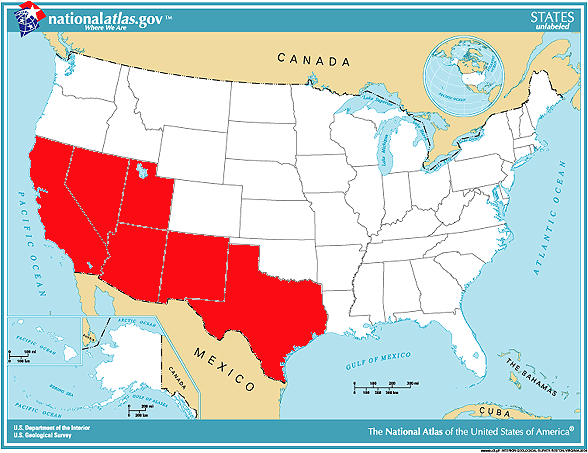Habitat
 Pogonomyrmex californicus is,
for the most part, found in dry and arid desert
locations, specifically in the southwestern part of the United
States in southern California, Nevada, southern Utah, Arizona,
southern New Mexico, and western Texas, as well as in the
Mexican states of Baja California, Sonora, and Chihuahua; it is
not found in any other location across the globe (De Vita 1979;
Navajo Nature 2010). The terrain where the ants live is very
flat and is mostly composed of gravel and sand with very little vegetation
(Navajo Nature 2010). These
conditions are necessary for
colonies to thrive.
Pogonomyrmex californicus is,
for the most part, found in dry and arid desert
locations, specifically in the southwestern part of the United
States in southern California, Nevada, southern Utah, Arizona,
southern New Mexico, and western Texas, as well as in the
Mexican states of Baja California, Sonora, and Chihuahua; it is
not found in any other location across the globe (De Vita 1979;
Navajo Nature 2010). The terrain where the ants live is very
flat and is mostly composed of gravel and sand with very little vegetation
(Navajo Nature 2010). These
conditions are necessary for
colonies to thrive.
California harvester ant colonies' nests are constructed in the
soil or beneath stones, in areas where there is generous exposure to the sun
- the entrances of these nests are often irregular in shape and
surrounded by a circular or semicircular crater of loose sand
(Navajo Nature 2010). On the same website, it was explained that
colonies are only sometimes constructed beneath stones, whereas
most other times, they are constructed in small to large soil mounds
with coverings of gravel. Worker ants "clean house," so to
speak, by altering the space nearest to the nest as a result of
clearing away plants and
other vegetation (Navajo Nature 2010).
Outside of the ant nests, there is a whole world of other organisms in the
desert. Organisms found in this environment include the Joshua
tree, ironwood, foothill palo verde, the giant saguaro, desert
pupfishes, the fringe-toed lizard, the shovel-nosed snake, and
the Panamint rattlesnake (Rundel and Gibson 1996).
Go back to the Classification page Go to the Home page Go on to the Form and Function page